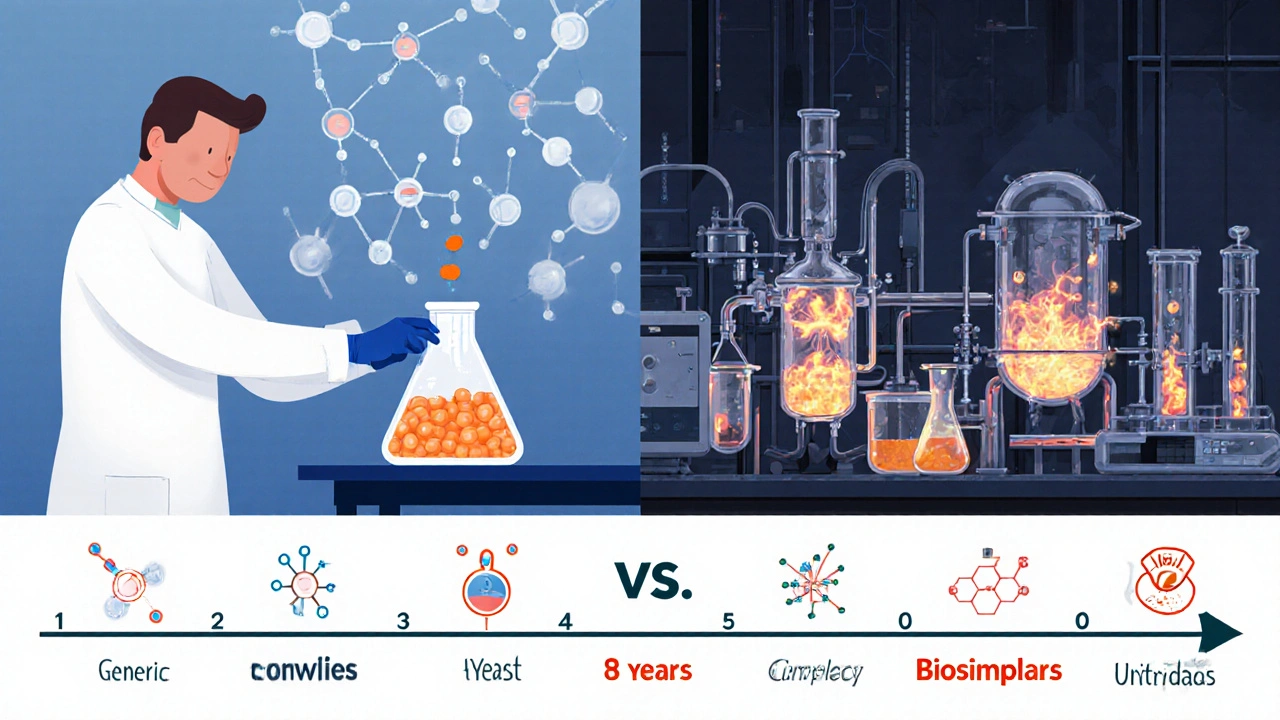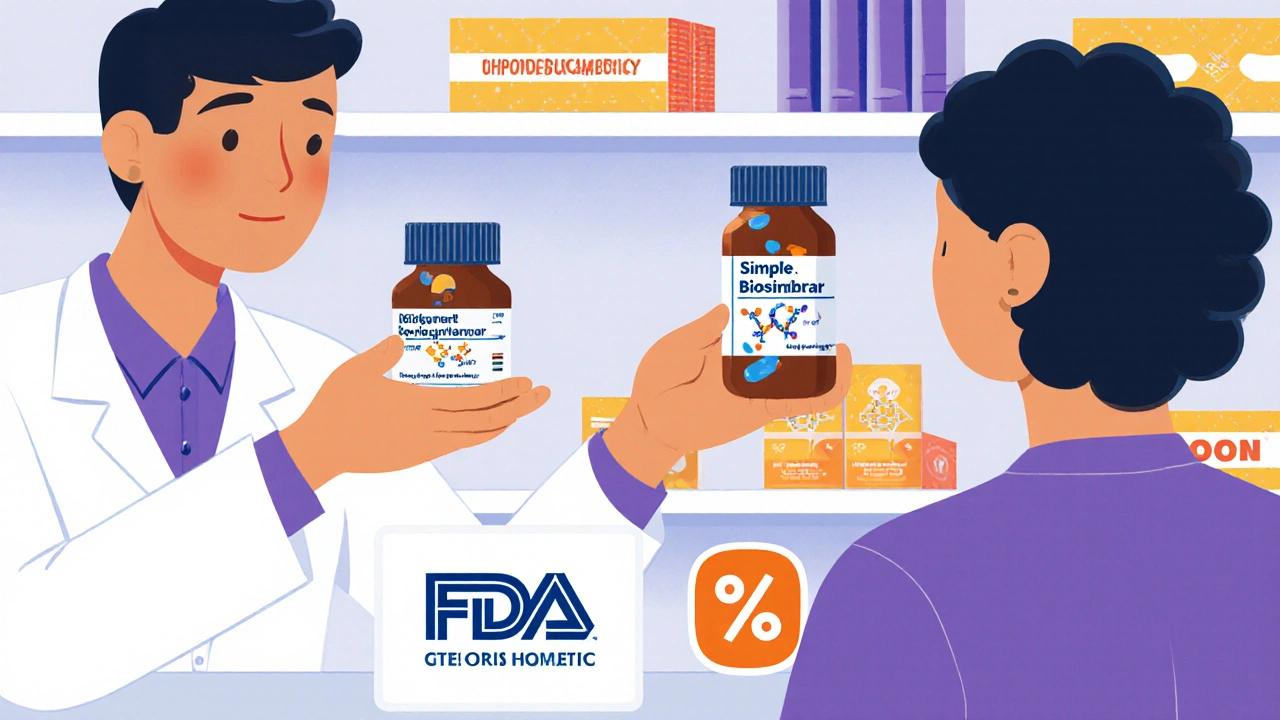When you’re prescribed a medication, you might see two options on your pharmacy receipt: a brand-name drug, or something cheaper labeled as a generic or a biosimilar. Both are meant to save you money, but they’re not the same thing-and confusing them can lead to unnecessary worry or even missed savings.
Let’s clear this up. Generics are the straightforward, cost-cutting cousins of small-molecule drugs. Think of them as exact chemical copies. If your doctor prescribes atorvastatin for high cholesterol, that’s the generic version of Lipitor. The active ingredient? Identical. The pill shape? Usually the same. The way your body absorbs it? Proven to be equivalent through strict testing. These drugs are made in labs using chemical reactions. They’re stable, easy to store, and often cost 80-85% less than the brand-name version. In the U.S., over 11,000 generic drugs are approved. Most people have used one without even realizing it.
Biosimilars, on the other hand, are not copies. They’re highly similar versions of biologic drugs-complex proteins made from living cells. These aren’t made in a test tube. They’re grown in bioreactors using living organisms like hamster or yeast cells. Because of this, no two batches are perfectly identical. Even tiny differences in how the cells are grown or purified can change the molecule’s shape ever so slightly. That’s why the FDA doesn’t call them “identical.” Instead, they’re approved as “highly similar” with no clinically meaningful differences in safety or effectiveness. Biosimilars target expensive biologics used for cancer, rheumatoid arthritis, Crohn’s disease, and diabetes. For example, a biosimilar of adalimumab (Humira) can cut monthly costs from $2,000 to around $1,600. Not as big a discount as generics, but still meaningful when you’re paying out of pocket or facing high insurance co-pays.
How They’re Approved: The Science Behind the Labels
The approval process for generics is streamlined but precise. Manufacturers must prove their version is bioequivalent to the brand drug. That means the amount of active ingredient your bloodstream absorbs (called AUC) and the peak concentration (Cmax) must fall within 80-125% of the original. This is usually tested in 50-100 healthy volunteers. No large clinical trials needed. The FDA calls this the Hatch-Waxman Act pathway, and it’s been working since 1984.
Biosimilars? It’s a whole different ballgame. Because they’re made from living cells, developers must do hundreds of analytical tests-mass spectrometry, chromatography, protein folding analysis-to prove the structure is nearly identical. Then they run animal studies and at least one clinical trial comparing safety, purity, and potency to the reference biologic. Sometimes they need multiple trials. The FDA requires a “totality of evidence” approach. This is why developing a biosimilar costs $100-250 million and takes 8-10 years. A generic? Around $2-3 million and 3-4 years.
When Can You Switch? Pharmacy Rules Vary
With generics, switching is usually automatic. In 49 U.S. states, pharmacists can swap a brand-name drug for a generic unless your doctor writes “dispense as written.” You might not even know it happened.
Biosimilars? It’s more complicated. Only those labeled as “interchangeable” can be swapped at the pharmacy without telling your doctor. As of 2025, just a handful of biosimilars have received this status in the U.S.-including Semglee (insulin glargine) and Cyltezo (adalimumab). Even then, 28 states require pharmacists to notify your prescriber within 72 hours of substitution. Some insurance plans won’t cover a biosimilar unless you’ve tried the brand first. Others require prior authorization forms that can take weeks to process.

Real-World Outcomes: Do They Work the Same?
For generics, the evidence is rock-solid. A 2019 JAMA study reviewed 47 clinical trials comparing brand and generic cardiovascular drugs. The results? No meaningful difference in heart attacks, strokes, or death rates. Patients on generics had the same outcomes-and saved thousands.
Biosimilars have a growing body of real-world data too. A 2022 review of 128 studies involving over 38,000 patients with rheumatoid arthritis found no increase in side effects or loss of effectiveness when switching from Humira to its biosimilar. In oncology, biosimilars of trastuzumab (Herceptin) and bevacizumab (Avastin) have shown identical tumor response rates in Medicare patients. One patient in New Zealand reported her out-of-pocket cost for bevacizumab dropped from $450 to $75 per infusion after switching to a biosimilar-without any change in her cancer markers.
But concerns linger. Some patients, especially those with inflammatory bowel disease, report anxiety after switching. A 2023 study found 19% of IBD patients felt less confident about their treatment-even though their disease activity scores stayed the same. A few patients noticed differences in how the injection pen felt or how the device worked. These aren’t safety issues-they’re about trust and experience.
Who Should Use Which?
If you’re taking a pill for blood pressure, cholesterol, thyroid issues, or depression-chances are a generic is your best, safest, and cheapest option. There’s no reason not to use it.
If you’re on a biologic-like an injection for psoriasis, Crohn’s, rheumatoid arthritis, or cancer-a biosimilar is often the smart next step. You won’t get the same 80% discount as with a generic, but you’ll still save 15-20%. And the science says it works just as well.
There are exceptions. If you’re on a drug with a narrow therapeutic index-where tiny changes in blood levels can cause serious side effects, like warfarin or lithium-doctors may be cautious about switching to anything new, even a biosimilar. But even here, evidence shows approved biosimilars are safe. The FDA and major medical societies like the American College of Rheumatology now recommend biosimilars as first-line treatment for many autoimmune conditions.

What You Can Do Today
- Ask your pharmacist: “Is there a generic or biosimilar version of my drug?”
- If you’re on a biologic, ask your doctor: “Has a biosimilar been approved for my condition?”
- Check the FDA’s Purple Book for biosimilars and Orange Book for generics-both are free online.
- Don’t assume a higher price means better quality. A biosimilar isn’t “weaker”-it’s just made differently.
- If you’re nervous about switching, ask for data. Most manufacturers provide patient guides explaining the science.
Many patients who switched to biosimilars report the same symptom control, fewer side effects, and lower stress about costs. One woman in Auckland switched from Humira to its biosimilar and saved $9,000 a year. She said the only difference was the packaging-and she didn’t even notice the change in how she felt.
What’s Coming Next?
The market is shifting fast. By 2027, biosimilars could make up nearly half of all biologic prescriptions in the U.S. The Inflation Reduction Act removed financial penalties for providers who use biosimilars, which is pushing hospitals and clinics to adopt them more widely. New biosimilars for drugs like Stelara and Keytruda are expected in 2025-2026, potentially saving billions.
Meanwhile, generics continue to dominate the market-over 90% of all prescriptions in the U.S. are for generics. They’re not going anywhere. And for the conditions they treat, they’re still the gold standard for affordability and reliability.
The bottom line? Don’t fear the label. Whether it’s generic or biosimilar, the goal is the same: get you the right treatment at a price you can afford. The science supports both. What matters most is that you stay on your treatment-and that’s easier when you’re not choosing between medicine and rent.
Are biosimilars safe?
Yes. The FDA requires biosimilars to undergo extensive testing to prove they’re as safe and effective as the original biologic. Real-world data from over 100,000 patients shows no increase in serious side effects or loss of effectiveness. The FDA’s Adverse Event Reporting System confirms biosimilars have safety profiles nearly identical to their reference products.
Can I switch from a brand-name biologic to a biosimilar?
Yes, and many patients do. Major medical societies, including the American College of Rheumatology and the American Society of Clinical Oncology, support switching. Studies show no increase in treatment failure or adverse events when switching from Humira, Enbrel, or Herceptin to their biosimilars. Your doctor will monitor you briefly after the switch, but most patients report no change in symptoms.
Why are biosimilars more expensive than generics?
Because they’re harder to make. Generics are simple chemical molecules you can replicate exactly. Biosimilars are complex proteins made in living cells-like cloning a tree instead of copying a key. The manufacturing process is expensive, requires specialized facilities, and takes years to develop. That’s why biosimilars cost $100-250 million to bring to market, compared to $2-3 million for generics.
Do biosimilars need refrigeration?
Most do. Because they’re made from proteins, biosimilars are sensitive to heat and light. They typically need to be stored between 2°C and 8°C (like a fridge). Generics, being chemical pills or liquids, are usually stable at room temperature. Always check the label or ask your pharmacist.
Will my insurance cover a biosimilar?
Most do-and often prefer them. Many insurance plans have lower co-pays for biosimilars. Some require you to try the brand first, but that’s changing fast. Medicare Part B now incentivizes providers to use biosimilars by removing financial penalties. If you’re denied, ask your doctor to file a prior authorization with clinical evidence supporting the switch.
If you’re unsure whether a biosimilar or generic is right for you, talk to your pharmacist or doctor. Bring your prescription and ask: “What’s the most affordable option that’s proven to work just as well?” You’re not just saving money-you’re making a smarter, science-backed choice.

